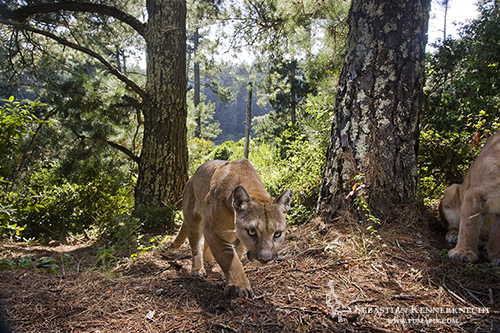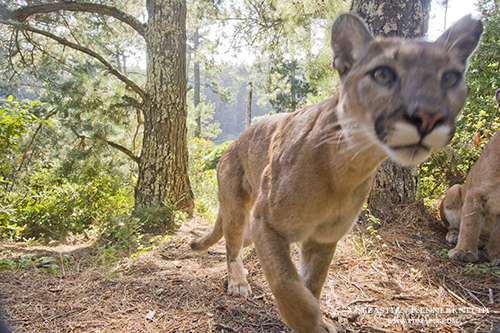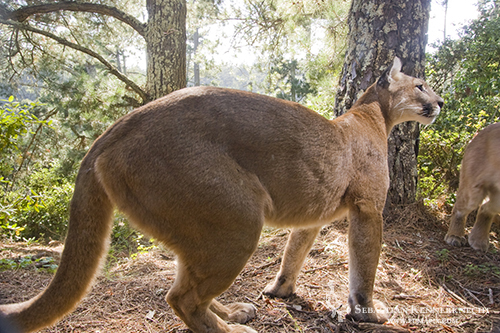Like most other felines, pumas live a rather solitary life. The only prolonged periods of time multiple animals spend time together is the 15 month period (on average) cubs spend with their mother.Though undoubtedly there are instances where cougars run into each other (like at a kill, for example when these two females with cubs met) but those encounters seem to be avoided by communication through various olfactory, visual, and auditory signs. Those same signs however can also be clues left by a female to signal a male she is sexually receptive. Researchers believe that urine marks and vocalizing are the primary ways a female advertises her ‘availability’. This vocalization is what is referred to as caterwauling and it is quite an impressive sound. Have a listen:
Audio of Female Cougar in Heat
That would get my attention as well, though I wouldn’t want to necessarily go towards the sound.
Female mountain lions have an estrus of four to twelve days with an average of seven to eight days (data from captive studies). This is a rather short period of time for a male to find a female when you occupy as large of home ranges as they do, so it makes sense to create an obvious ‘hey, I am right here!’ kind of signal. Once they do find each other a breeding pair will stay together for one to sixteen days with one to four days being most typical. After the business is done the male will leave again (I know, I know, typical male behavior….).
So, is this meet up of two mountain lions a mating pair in the pictures below. The mountain lion front and center is our resident female, Artemis (named so after the Greek goddess of the hunt, based on her forehead mark resembling Artemis’s bow — can you tell my girlfriend came up with that one??) but if you look carefully on the right there is another puma, a rather large puma, sitting off to the side.
Is it a male? What do you think? If it is indeed a male and breeding was successful then we may have kittens starting around about October 15th of this year….time will tell!
Bibliography:
Ross, P.I. and M.G. Jalkotzy. 1992. Characteristics of a hunted population of cougars in southwestern Alberta. Journal of Wildlife Managment. 56:417-426
Mehrer, C.F. 1975. Some aspects of reproduction in captive mountain lions Felis concolor, bobcats Lynx rufus, and lynx Lynx canadensis. Ph.D. dissertation, University of North Dakote, Grand Forks.
Rabb, G.B. 1959. Reproductive and vocal behavior in captive mountain lions.
Seidensticker, J.C., M.G. Hornocker, W.V. Wiles, and J.P. Messick. 1973. Mountain Lion social organization in the Idaho Primitive Area. Wildlife Monogram 35: 1-60
Audio Courtesy of Felidae Conservation Fund.




Looks much too large to be a kitten still with her, so unless it is an adult offspring that she separated with long ago and came back for a quick friendly visit I would have to guess that it is a new boyfriend. Here’s hoping for kitten pictures!
Wow, once again really beautiful images!